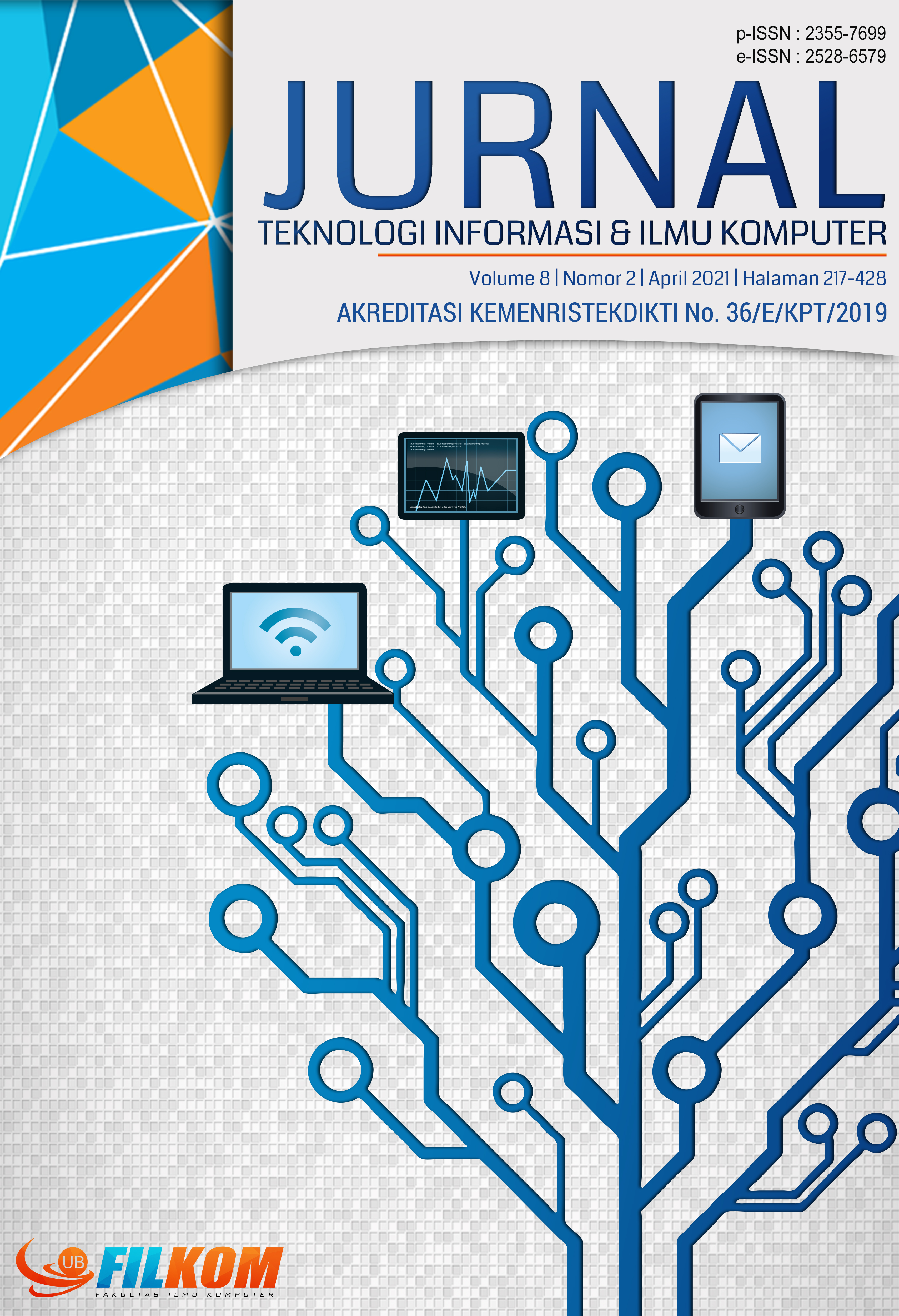Pembangunan Aplikasi Mobile Pengenalan Objek Untuk Pendidikan Anak Usia Dini
DOI:
https://doi.org/10.25126/jtiik.2021824363Abstrak
Penggunaan ponsel sudah sangat erat dengan kehidupaan anak usia dini sehingga menimbulkan beberapa dampak negatif bagi anak usia dini terutama berkurangnya interaksi dengan dunia sekitarnya. Salah satu teknologi yang dapat dikembangkan pada ponsel adalah computer vision. Salah satu penggunaan computer vision adalah object recognition yang memberikan solusi untuk membantu mengenali objek. Pada penelitian ini dibangun sistem pengenalan objek benda di dalam rumah yang diaplikasikan pada ponsel yang diharapkan membantu anak usia dini mengenali benda disekitarnya. MobileNet merupakan salah satu feature extraction yang memiliki kinerja yang baik dan ringan digunakan pada perangkat ponsel. Arsitektur MobileNet terdiri dari layer depthwise convolution dan layer pointwise convolution dalam mengekstraksi fitur. Percobaan ini juga menggunakan arsitektur Single Shot Multibox Detector (SSD) sebagai metode dalam mendeteksi objek. Pre-trained model dari dataset COCO digunakan pada eksperimen, untuk mengenali 20 jenis objek benda di dalam rumah. Dari hasil eksperimen, MobileNetV2 menghasilkan nilai mean Average Precision (mAP) yang lebih baik dibandingkan dengan MobileNetV1 dan InceptionV2, yaitu sebesar 99,34%.
Abstract
Mobile phone usage has been very close to early childhood life, so giving rise to some negative impact on early childhood, especially reduced interaction with the surrounding world. One of the technologies that can be developed on the cellphone is computer vision. One of the uses of computer vision is object recognition that provides solutions to help to recognize objects. This research builds a system for recognition objects inside in house that is developed on a cellphone that is expected to help early childhood recognize objects in the surrounding. MobileNet is one of feature extraction that has good performance and efficient use on a cellphone. MobileNet architecture consists of a depthwise convolution layer and pointwise convolution layer in extracting features. The experiment also uses the architecture of Single Shot Multibox Detector (SSD) as a method of detecting objects. We used MobileNet architecture as a pre-trained model that had previously been trained on COCO datasets, and implement transfer learning for 20 types of objects commonly found inside the house. The experimental result indicates that the mean Average Precision (mAP) of MobileNetV2 could exceed MobileNetV1 and InceptionV2 of 99.34%.
Downloads
Referensi
DU, C.J., CHENG, Q., 2014. Computer Vision. In: O'Donnell C., Fagan C., Cullen P. (eds) Process Analytical Technology for the Food Industry. Food Engineering Series. Springer, New York, NY.
HADDON, L., 2013. Mobile media and children. Mob. Media Commun.
HENDERSON, P. dan FERRARI, V. 2017. End-to-end training of object class detectors for mean average precision. Lecture Notes in Computer Science (including subseries Lecture Notes in Artificial Intelligence and Lecture Notes in Bioinformatics)
HOWARD, A. G. dkk., 2017. MobileNets: Efficient Convolutional Neural Networks for Mobile Vision Applications. ArXiv.
HOSANG, J., BENENSON, R., AND SCHIELE, B., 2017. Learning non-maximum suppression. Proceedings - 30th IEEE Conference on Computer Vision and Pattern Recognition, CVPR.
HUA, B., TRAN, M.-K, AND YEUNG, S.-K., 2018. Pointwise Convolutional Neural Networks. Cvpr.
LIN, T. Y. dkk, 2014. Microsoft COCO: Common objects in context. Lecture Notes in Computer Science (including subseries Lecture Notes in Artificial Intelligence and Lecture Notes in Bioinformatics)
LIU, W. dkk, 2016. SSD: Single shot multibox detector. Lecture Notes in Computer Science (including subseries Lecture Notes in Artificial Intelligence and Lecture Notes in Bioinformatics).
PAN, S. J. dan YANG, Q. 2010. A survey on transfer learning. IEEE Transactions on Knowledge and Data Engineering.
ROSENBROCK, A., 2017. Intersection over Union (IoU) for object detection. Pyimagesearch.com.
SANDLER, M., ZHU, M., ZHMOGINOV, A. dan JAN, C.V., 2018. Inverted Residuals and Linear Bottlenecks: Mobile Networks for Classification, Detection and Segmentation. CVPR.
SANDLER, M., HOWARD, A., ZHU, M., ZHMOGINOV, A. dan CHEN, L. C., 2018. MobileNetV2: Inverted Residuals and Linear Bottlenecks. Proceedings of the IEEE Computer Society Conference on Computer Vision and Pattern Recognition.
SZEGEDY, C., VANHOUCKE, V., IOFFE, S., SHLENS, J., dan WOJNA, Z., 2016. Rethinking the Inception Architecture for Computer Vision. Proceedings of the IEEE Computer Society Conference on Computer Vision and Pattern Recognition, pp. 2818-2826
WANG, G., YUAN, G., LI, T. dkk, 2018. An multi-scale learning network with depthwise separable convolutions. IPSJ T Comput Vis Appl 10 (11)
Unduhan
Diterbitkan
Terbitan
Bagian
Lisensi

Artikel ini berlisensi Creative Common Attribution-ShareAlike 4.0 International (CC BY-SA 4.0)
Penulis yang menerbitkan di jurnal ini menyetujui ketentuan berikut:
- Penulis menyimpan hak cipta dan memberikan jurnal hak penerbitan pertama naskah secara simultan dengan lisensi di bawah Creative Common Attribution-ShareAlike 4.0 International (CC BY-SA 4.0) yang mengizinkan orang lain untuk berbagi pekerjaan dengan sebuah pernyataan kepenulisan pekerjaan dan penerbitan awal di jurnal ini.
- Penulis bisa memasukkan ke dalam penyusunan kontraktual tambahan terpisah untuk distribusi non ekslusif versi kaya terbitan jurnal (contoh: mempostingnya ke repositori institusional atau menerbitkannya dalam sebuah buku), dengan pengakuan penerbitan awalnya di jurnal ini.
- Penulis diizinkan dan didorong untuk mem-posting karya mereka online (contoh: di repositori institusional atau di website mereka) sebelum dan selama proses penyerahan, karena dapat mengarahkan ke pertukaran produktif, seperti halnya sitiran yang lebih awal dan lebih hebat dari karya yang diterbitkan. (Lihat Efek Akses Terbuka).















